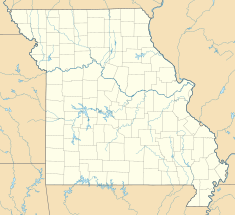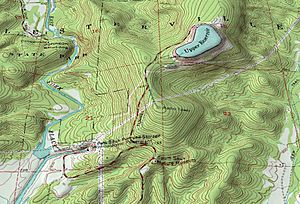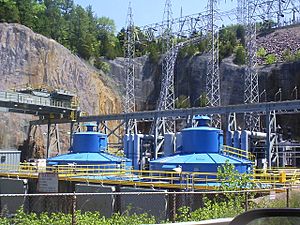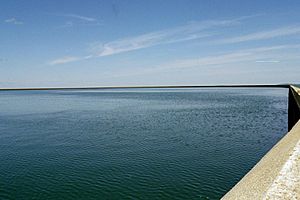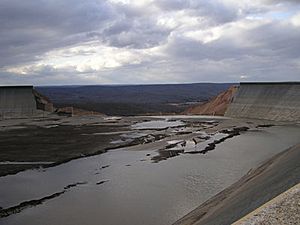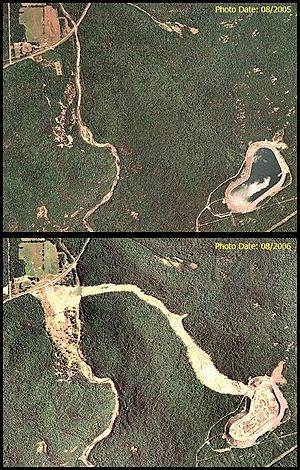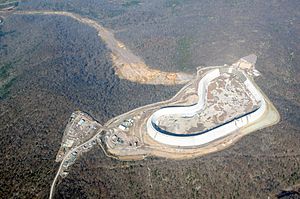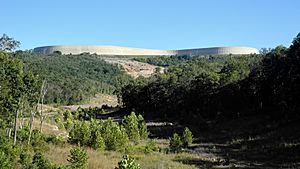Taum Sauk Hydroelectric Power Station facts for kids
Quick facts for kids Taum Sauk Hydroelectric Power Station |
|
|---|---|
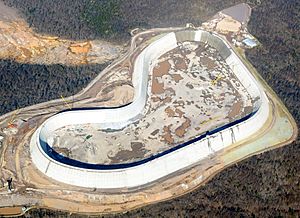
The rebuilt upper reservoir of the Taum Sauk plant, nearing completion in this photo, is the largest roller-compacted concrete dam in North America.
|
|
|
Location of Taum Sauk Hydroelectric Power Station in Missouri
|
|
| Country | United States |
| Location | St. Francois Mountains, Missouri |
| Coordinates | 37°32′08″N 90°49′05″W / 37.53556°N 90.81806°W |
| Purpose | Power |
| Status | Operational |
| Construction began | 1960 |
| Opening date | December 20, 1963, April 15, 2010 |
| Construction cost |
|
| Owner(s) | Ameren Missouri (previously AmerenUE, formerly Union Electric) |
| Operator(s) | Ameren Missouri |
| Dam and spillways | |
| Type of dam | Gravity dam |
| Height (foundation) | 125 feet (38 m) |
| Length | 6,800 feet (2,100 m) |
| Elevation at crest | 1,601 feet (488 m) |
| Width (crest) | 25 feet (7.6 m) |
| Width (base) | 150 feet (46 m) |
| Dam volume | 3,200,640 cubic yards (2,447,060 m3) |
| Spillways | 1 |
| Spillway type | Broad crested weir |
| Spillway capacity | 5,358 cubic feet per second (151.7 m3/s) |
| Reservoir | |
| Total capacity | 4,350 acre-feet (5,370,000 m3) |
| Surface area | 54.5 acres (22.1 ha) |
| Maximum water depth | 120 feet (37 m) |
| Normal elevation | 1,597 feet (487 m) |
| Power station | |
| Name | Power Station |
| Coordinates | 37°31′14″N 90°50′04″W / 37.52056°N 90.83444°W |
| Operator(s) | Ameren Missouri |
| Commission date | December 20, 1963, April 15, 2010 |
| Type | Pumped-storage |
| Hydraulic head | 860 feet (260 m) |
| Installed capacity | 450 |
| Capacity factor | 5–8% |
| Annual generation | -148 |
| Website Taum Sauk Energy Center |
|
The Taum Sauk pumped storage plant is a special kind of power station located in the St. Francois Mountains of Missouri, United States. It's about 90 miles south of St. Louis near Lesterville, Missouri. This plant is run by Ameren Missouri.
This pumped-storage hydroelectric plant was built between 1960 and 1962. It started working in 1963. Its main job is to help provide extra electricity when people need it most during the day. Water flows from a reservoir on top of Proffit Mountain down to a lower reservoir. This water spins Electrical generators to make power. At night, when electricity is cheaper and there's more of it, the plant uses that power to pump the water back up the mountain.
The Taum Sauk plant is unique because it's an "open-loop pure pumped" system. This means there's no natural river flowing into the top reservoir to fill it. All the water has to be pumped up. Even though it uses more power to pump water up than it makes when the water comes down, it's still useful. This is because it pumps water at night when electricity is cheap. Then, it generates power during the day when electricity is expensive. It's like a giant battery for the power grid.
On December 14, 2005, the upper reservoir dam broke. This stopped the plant from working for several years. It was rebuilt and started running again on April 21, 2010. The new dam is the biggest roller-compacted concrete dam in North America.
Contents
Plant Size and Location
The upper reservoir can hold about 1.5 billion US gallons of water. Its wall is nearly 100 feet tall. This reservoir sits 760 feet above the 450 MW hydroelectric plant. This height difference, called "head," is even greater than that of Hoover Dam. A 7,000-foot-long tunnel connects the two reservoirs through the mountain.
The Taum Sauk upper reservoir is on Proffit Mountain. It is not on Taum Sauk Mountain, which is about 5 miles to the east. You can see the plant from Route 21 and from Route N near Johnson's Shut-Ins State Park.
Before the dam failed, visitors could drive to the top of Proffit Mountain. There was an observation deck to view the reservoir. Ameren also had a museum at the entrance. It showed the interesting natural history and geology of Missouri. Geology students often visited the power plant. They came to see the ancient rock layers exposed during its construction.
Plant History
Choosing the Site
In 1953, the Union Electric Company started looking for a place to build a new pumped storage plant. By 1958, they focused on spots with at least 300 feet of vertical drop. This would let them use a smaller reservoir. They hired Sverdrup-Parcel & Associates to check out sites in the St. Francois Mountains. These mountains were close to St. Louis, where Union Electric was based. They also had big height differences, which was perfect.
Sverdrup-Parcel & Associates first wanted to suggest Taum Sauk Mountain. It's the highest point in Missouri. But people didn't want a power plant on this beautiful mountain. So, it was ruled out. Instead, Proffit Mountain was chosen. It was almost as high (1,720 feet). It was also close to the East Fork of the Black River. Plus, it was only 27 miles from the existing power lines.
Building the Plant
Construction of the Taum Sauk plant began in 1960. The building team included Fruin-Colnon Construction and Utah Construction and Mining Company. The plant started working in 1963. It had two special pump-turbine units. Each unit could generate 175 MW of power.
At first, Union Electric said they didn't need a license from the US Federal Power Commission (FPC). They argued that the FPC didn't have power over the river where the plant was built. However, the United States Supreme Court decided in 1965 that the FPC did have power. So, Taum Sauk needed a license, which it received later.
When it was finished, the Taum Sauk plant was the largest pumped storage plant in North America. It was a big step forward for this type of power technology. Its pump-turbines were the biggest ever made at that time. It also had a very high "head" (height difference for the water). It was the first large pumped-storage station in the US. The plant could even start up without outside power, which is called "black start capability." It could also be controlled from far away or even run completely by itself. Taum Sauk was also the first plant in the US that only used pumped water.
Plant Upgrades
In July 1972, the pump-turbine units were improved. Their power output increased from 175 MW to 204 MW each. This raised the plant's total power from 350 MW to 408 MW.
From 1998 to 1999, the parts of the turbines that spin were upgraded again. This made the water flow better and increased the power even more. Each unit could then make 225 MW, for a total of 450 MW.
Small leaks in the reservoir led to building a pond and pump to collect and return the water. Later, a special lining material was put in the reservoir itself. This was done from September to November 2004 to reduce leaks.
The plant was named an IEEE Milestone in October 2005. This was just a few months before the upper reservoir failed. It was given the IEEE Milestone honor again in 2010 after the new dam was finished.
2005 Upper Reservoir Failure
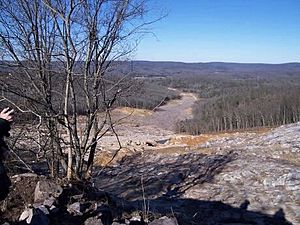
At 5:12 a.m. on December 14, 2005, the northwest side of the upper reservoir overflowed. Water kept being pumped into the reservoir even after it was full. This caused a large part of the reservoir wall to break. About 1 billion US gallons of water rushed out in just 12 minutes. This sudden release sent a 20-foot-tall wave of water down the East Fork of the Black River.
The dam failed because of several problems. There were issues with how it was designed and built. Also, the plant kept running even though the main system for checking water levels was known to be wrong. The backup system was also moved too high. The dam was also operated unsafely by regularly overfilling the reservoir. The original reservoir did not have a way for extra water to flow out safely.
A memo from the plant's superintendent, Richard Cooper, mentioned an "overflow like Niagara Falls" on September 27. This happened at the same spot that later broke. Another memo from Cooper warned that the gauges used to check water height were not working in October.
No one died in the failure. The superintendent of Johnson's Shut-Ins State Park and Taum Sauk Mountain State Park, Jerry Toops, and his family were at home when the water hit. Their home was destroyed. They survived, but had injuries and suffered from the cold. The children were taken to a hospital in St. Louis and later released.
The dam of the lower reservoir held strong. It was designed to hold most of the water from the upper reservoir. By holding back the flood, it protected towns downstream like Lesterville and Centerville. People in those areas were asked to leave their homes for safety, but there was no damage. The high water stopped at Clearwater Lake, whose dam was not harmed.
Investigations and Settlements
The US Federal Energy Regulatory Commission (FERC) fined Ameren US$15 million for the dam break. This was the largest fine in FERC's history. The State of Missouri also sued Ameren. They said Ameren was careless in running the plant.
Investigations looked into what happened. The Missouri Public Service Commission (PSC) found that Ameren's management was responsible for the accident. They stated that Ameren knew the risks of overfilling the reservoir. They also knew the water level gauges were not working correctly. The PSC called Ameren's decision to keep operating the plant "reckless."
By late 2011, Ameren had paid almost US$200 million in settlements related to the 2005 dam failure.
Rebuilding the Dam
Federal regulators approved Ameren's plan to rebuild the reservoir. Construction started in late 2007. The new dam is made entirely of roller-compacted concrete. This is different from the original earth-fill dam. The new design includes better ways to detect water levels. It also has a spillway that can handle any overflow, even if both pumps are running at full power. A video system also helps monitor the water level. The rebuild cost US$490 million, partly covered by insurance. Ameren was not allowed to charge its customers for the rebuilding costs.
Water was pumped into the rebuilt reservoir for the first time on February 27, 2010. Engineers carefully watched the new structure as water levels were changed. The plant received final approval to return to normal operations on April 1, 2010. It met Missouri's operating standards on April 15. Electricity was first generated from the new dam on April 21, 2010. The United States Society on Dams gave the new dam an "Award of Excellence." On September 27, 2010, the IEEE honored the plant again as an IEEE Milestone.
Images for kids
-
A broad swath of dense forest was washed away and scoured to bedrock by the escaping flow. Source: FERC


